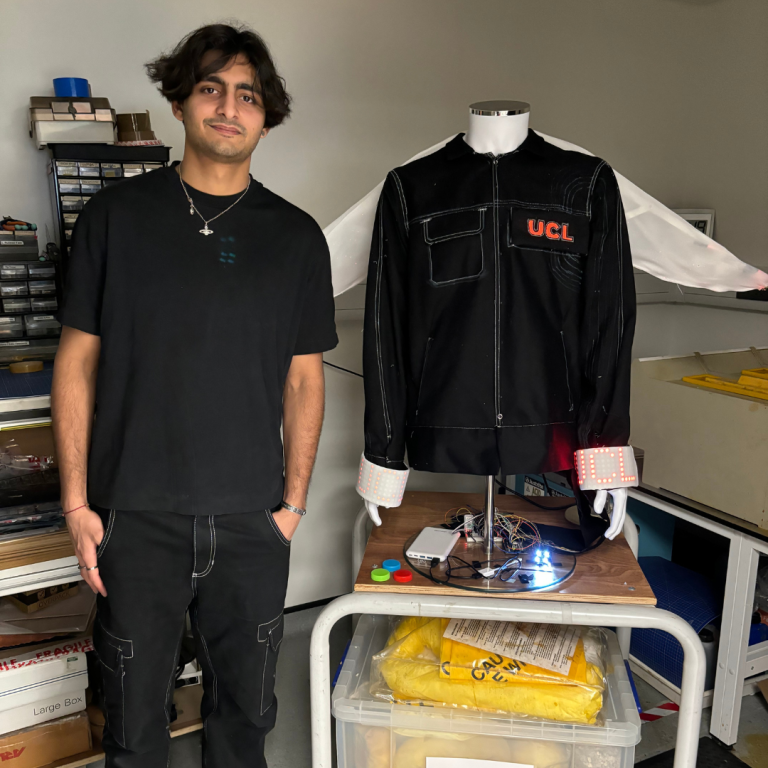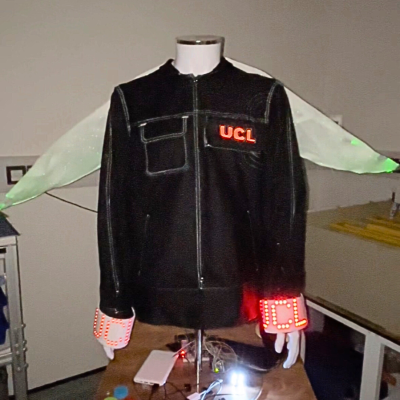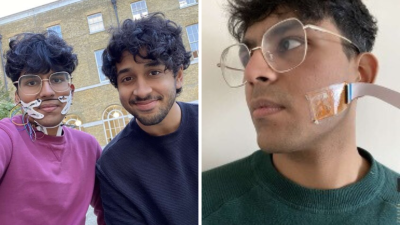Celebrating Third-Year Engineering Projects
26 March 2024
The Roberts Building was abuzz with excitement as the department celebrated the achievements of third-year engineering students.

The students have poured their creativity, knowledge, and practical skills into a series of captivating course projects that push the boundaries of innovation. From wearable technology to sustainable energy solutions, their work exemplifies the spirit of engineering excellence.
One standout project that has garnered attention is the development of Modular Fabric Integrated Circuits (FICs) for wearable technology. Spearheaded by Vir Morjaria, a final year BEng student in Electrical and Electronic Engineering (EEE), this project seamlessly blends fashion and functionality.

Jacket designed by UCL EEE student Vir Morjaria
Vir designed and created a denim jacket that seamlessly integrates LED matrices, an electroluminescent panel, RGB optical fibre fabric, and a servo motor wing module. Controlled via Bluetooth, this wearable marvel dynamically adjusts its wing colour based on the wearer’s surroundings. Vir’s project exemplifies the intersection of creativity, engineering, and style and the confidence to experiment with an interdisciplinary approach to his engineering ideas.
“My ambition is to merge technology with nature, specifically to combine engineering with fashion. Despite rapid evolution within the fashion industry, I believe there is a lot of opportunity to integrate transformative technologies that bring a fresh perspective to fashion and design.”
Another memorable project was a silent-speech interface which uses electromyography (EMG) AKA muscle activation signals in facial muscles to decode quietly mouthed speech.

(Left) a custom electrode brace and (right) Sudharshan wearing electrodes
“In a "full-stack" problem like this, there are a lot of variables ranging from the ML models that are used to the multiplexers used in the system. I learnt a lot about how to be more methodical in only changing one variable at a time to not get confused, keeping detailed logs and avoiding getting distracted with premature optimisation.”
Sudharshan has also founded a company called Epiph, fuelled by the recent breakthroughs in large-language models.
“Our first product is Dock, a silent speech interface that acts as your second brain and allows you to access the world's knowledge, as though it's inside your head.”
The ingenuity displayed by UCL students serves as a testament to the transformative power of engineering and the mission to promote radical and critical thinking. The department looks forward to continuing to foster creativity, curiosity, and excellence in engineering education and research at UCL EEE.
Watch a video of the jacket in motion
 Close
Close

